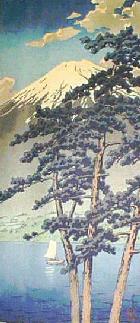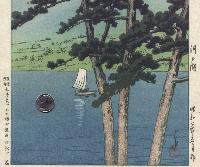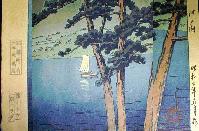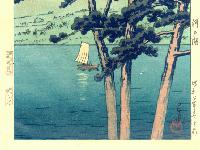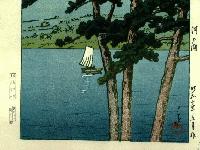- Doi printers
- Doi articles
- Case study
Title: Kawaguchi Ko (Lake Kawaguchi)
Artist: Kawase Hasui
Publisher: Doi
Date: Showa 7.5 (May, 1932)
| State A
Publisher: Doi Teiichi
| |
| State B
Publisher: Doi Hangaten
| |
| State C
Publisher: Doi Hangaten
| |
| State D
Publisher: Doi Eiichi
|
Deterioration of the Key Block's Finer Lines
1. Tree Trunk Lines
In print A, the tree trunk next to the sailboat has about seven separate line segments running parallel to the line of the trunk, about a millimeter in from the left side of the trunk. This series of line segments starts just a bit higher than the highest point on the sail, and extends down about 5 centimeters, to below where the bough comes across the trunk.
In print B, the upper part of this line has run together, but there is still a separate line segment below the bough. In print C, this is a single line of varying thicknesses, but definitely a solid, connected line. In print D, the same line has become so coarse as to almost blend in with the left line of the trunk.
| Technical commentary |
2. Dots on the Shore
There are dots on the shore to suggest shrubbery. In some places, the dots on prints A and B are more distinct and separate than the dots on print C. On print D, there are many places where the dots have run together.
| Technical commentary |
Unexplained Anomalies
1. Shading on the Lowest Bough
Prints B,C and D have darker shading in the lowest bough of the tree, which is consistent with the shading in the other parts of the tree. Print A is missing that shading at the lowest part of that bough, even though it is present in the upper part.
| Technical commentary |
2. The Sail's Reflection in the Water
The sail's reflection in the water is the same shape in prints A, B, and C. In print D, it is a different shape, with a curve to the left. Does this mean that (at least) part of the wood block was replaced?
| Technical commentary |
3. Shading on the Sail
The lines in the sail in print A have a blue highlighting. There is a yellow shadow on the sail in prints B and C. Print D is missing both of these features.
| Technical commentary |
4. Four Ripples in an Arc
On prints B and C, there is a pattern of four dark ripples in an arc, starting at the left margin and stretching through the bottom of the sail's reflection to the tree. Print A is missing all of these ripples except the one next to the margin. On print D, the rightmost ripple (the one next to the tree) is missing.
| Technical commentary |
Position of Signature and Red Hasui Seal
While the position of the signature seems to be consistent, there are slight differences in the relative position of the red Hasui seal in each of the prints. This leads one to the conclusion that the signature is part of the keyblock, while the seal is an actual seal applied independently of the blockprinting process.
| Technical commentary |
Format of Publisher/Printer/Carver Information
Most Doi prints that I have seen have the multiple box format as in prints B, C and D. The format on print A is certainly the exception.
It is perhaps possible that the left margin text from print A was carved into the keyblock. If that were the case, then that area of the keyblock would have been removed for subsequent printings. The relative darkness of left margin text might seem to support this theory, as does the deterioration of the key block's finer lines. The publisher's info in the left margin of print A is equally dark as the title and date in the right margin. The left margin info of prints B, C and D is lighter than the keyblock text in the right margin, implying that it was applied as stamps, independently of the keyblock printing.
| Technical commentary |
Printer and Carver Information
It is hard to understand that print A is attributed to the carver Katsumura while prints B, C, and D are attributed to Harada. Indeed, the evidence seems to indicate clearly that these prints came from the same blocks. Some of the anomalies noted above defy explanation, but none of them support Doi's "claim" that there were different carvers.
According to what we know of the chronology of Doi's printers, the progression of printers is plausible: Matsushita (A), Ito (B), Yokoi (C), and Hamano (D). Both Matsushita and Ito worked for Doi in the early 1930's. Yokoi worked from the early 1930's through 1945. Hamano started printing for Doi in 1993.
| Technical commentary |
Summary
These dates, along with the deterioration of the keyblock lines and dots, give us a set of consistent evidence of the order in which these prints were produced. Print A is almost certainly a "first" printing, from 1932. Print B is probably from no later than 1935. Print C was produced sometime between the production date of Print B and 1945. Print D was produced in 1993 or sometime after that.
The unfortunate conclusion is that Doi was less than accurate in attributing work to carvers. By extension, the attribution of work to printers may also be inaccurate. This throws into question the wisdom of trying to use printers' seals to date Doi prints. However, even with this shadow of doubt, the chronology of printers is probably the best tool available to a collector attempting to age a Doi print.
| Technical commentary |
Original text as written and submitted by Marc Kahn for this article is his property, copyright © 1999, all rights reserved.
Your feedback is welcomed -- please send in your comments and suggestions.
